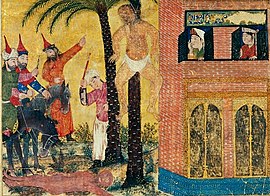Mani Religion Vision Unveiling : A Captivating History.

Mani Religion (Manichaeism) Mani Religion was an Iranian prophet and the founder of Manichaeism, a religion most prevalent in late antiquity.
Mani was born in or around Ctesiphon (south of modern Baghdad) in Mesopotamia, then part of the Parthian Empire. Seven of his major works are written in Syriac whilst the eighth (dedicated to Shapur I) in Middle Persian. He died shortly thereafter in prison at the hands of Bahram I in Gundeshapur.
Sources of Mani Religion
A Greek parchment codex of c.AD 400 was found in Upper Egypt in 1969. It is known today by the name Codex Manichaicus Coloniensis, as it is held at the University of Cologne.
A hagiographic narrative of Mani’s career and spiritual development with information about Mani’s religious teachings containing fragments of their writings, it has come to be regarded as the best source of information we have about the historical Mani.
Works
Mani’s canon consists of six works in Syriac, and one in Persian: the Shapuragan. While none of his books are extant in full, there is a huge body of fragments and quotations, including a long Syriac quotation from one of his books, as well as a bulk of material in Middle Persian, Coptic and many other languages.
Core Beliefs and Teachings
They have very unique things that they believe in Manichaeism. It promotes a dualistic worldview. That means there is a perennial struggle between good and evil. Light symbolizes good. Darkness symbolizes evil.
The Two Realms
Manichaeism splits the world into two realms. Anganda nari maya and Sathya is pure and divinely light. The dark is chaotic and evil. The purpose of existence is to be freed from the darkness.
The Role Of Human Beings
There is light and darkness in human race. It is their task to release the light bound in their flesh. This is achieved by virtuous actions and spiritual rituals.
Holy Texts
Manichaeism has multiple holy books. The “Shabuhragan” is the most significant. A man named Mani wrote it for the Persian king Shapur I The Gospel of Mani and the Treasure of Life are other texts.
Spread of Mani Religion
Manichaeism spread quickly. It went to the Roman Empire, India and China. His followers were active proselytizers. They went far and wide to teach his teachings.
In The Roman Empire
It entered Rome in the 3rd century. It was persecuted into the Roman authorities. And yet, it attracted a lot of adherents.
In The East
Manicheism reached India and China. In the Tang Dynasty, it became popular in China. The religion has influenced Chinese art and literature.
Persecution and Decline
It is also not without persecution in various places, Manichaeism. It was banned in the Roman Empire. In Persia, it was viewed as a danger to Zoroastrianism. The faith waned over the years.
In The Roman Empire
Manichaeism was viewed as a threat by the Roman authorities. They used its followers as their scapegoats. Many of the people were imprisoned or executed.
In Persia
Manichaeism was opposed by Zoroastrian priests. They saw it as a rival faith. Mani was arrested and died in jail.
In China
Manichaeism had its highs and lows in China. It has been outlawed at various times. It did impact Chinese culture, however.

Credit: www.alamy.com
Influence on Other Religions
Manichaeism exercised some influence on other religions as well. Never mind that it affected Christianity, Islam, and Buddhism.
On Christianity
Manichaeism had influenced some early Christian thinkers. Saint Augustine followed before becoming a Christian.
On Islam
Islamic sects exhibit Manichaean influences. They both have a goodness versus evil duality.
On Buddhism
Buddhist art and literature was influenced by Manichaeism. It’s found in some Buddhist texts as well, with the ideas sharing a Manichaean bent.
Legacy of Mani Religion
The stamp of Manichaeism endures. It has many ideas that influenced many cultures and religions. While it did decline, its will still looms large.
Art And Literature
The art of Manichaeism is beautiful. It had an impact on Persian and Chinese art. Manichaean writings are studied for their literary value.
Modern Interest
Manichaeism more is a focus of scholars wishing to gauge its influence. Contemporary spiritual seekers find its teachings appealing.
Mani Religion, or Manichaeism, was one of the world’s great faiths. It draws from different traditions. And despite persecution, it took root everywhere. It has had impact on many other religions and cultures. Mani, and the legacy of Guido and his teachings, continues to inspire.
F A Q
What Is Mani Religion?
Originally founded in the 3rd century by the prophet Mani, the ancient dualistic faith known as Mani religion, or Manichaeism, teaches that the world is in a battle between good and evil.
Who Founded Mani Religion?
The prophet Mani, who founded “Manichaeism” in Persia in 216 A. D.
What Is the Importance of Mani Religion?
Manichaeism is important for its dualistic worldview and its growth through history.(Quote source:)
How Did Mani Religion Spread?
This was, in large part, due to its missionary successes and attractive doctrines.



